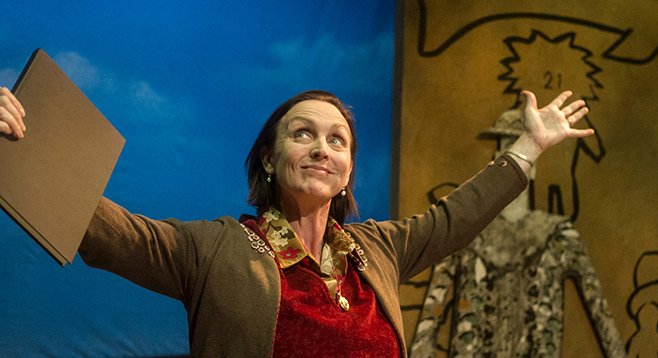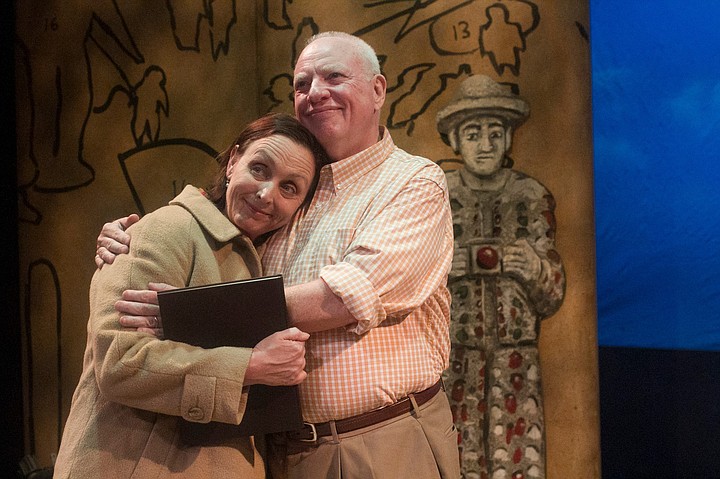 Facebook
Facebook
 X
X
 Instagram
Instagram
 TikTok
TikTok
 Youtube
Youtube

If you’ve seen that look, that frozen Alzheimer’s stare, on the face of a loved one, you have to wonder what’s inside. If, that is, you can get past the unthinkable horrors a.) of no longer being recognized and b.) that, though standing before your eyes, the loved one is no longer there.
Are they alert? In a mental coma? Do they make sense of our words but can’t reply? Or is their mind degenerating, one memory at a time, to a clean slate?
Laura Jacqmin’s Milvotchkee, Visconsin takes a sometimes quirky, ultimately moving insider’s look at dementia.
Molly has been a docent at Wisconsin Concrete Park for more than 30 years. Along with the Wisconsin Dalles — a beautifully steep, circuitous gorge on the St. Croix River — it’s one of the sites to see in Wisconsin.
Molly knows as much about the park as its creator, Fred Smith. He couldn’t read or write but sculpted mythical figures from pictures, among them Ben-Hur, Paul Bunyan, and Sacajawea, the Native American guide for Lewis and Clark.

But something’s happened to Molly. What she knows is slowly becoming what she can’t recall. Now she must consult a notebook when a reference won’t leap to mind.
Lightning struck Fred Smith. Molly figures that’s what happened to her. She has a hole in her head, from which words and ideas trickle away.
To account for the gradual loss, and for the changing world around her, Molly improvises: she converses with her late husband and takes joyrides. A cameo appearance by the hole gradually takes center-stage.
Jacqmin wrote the play from Molly’s point of view. Some of the early scenes, in the writing, labor for surreal effects and a lighthearted approach. They verge on cute. And would even more of director Robert Barry Fleming weren’t in charge (and didn’t have first-hand knowledge of Alzheimers, from which his mother suffers).
Throughout the 95-minute piece, Fleming adds deft touches — some funny, some poignant — to fill in slyly where the script of this “comedy about a tragedy” wanes.
Not that she had to, but Linda Libby validates her Craig Noel “Actor of the Year” award for 2013 with an outstanding portrayal of Molly. Her eyes — that look of loss and the horror that it’s not reversible — are eloquent. Elizabeth Kubler-Ross and others identified seven stages of grief (denial, anger, bargaining, depression, shock or disbelief, guilt, and acceptance). Molly/Libby probes each with stark, fragile, touching believability, and humor. Excellent work!
Fine support work comes from David Poirier (a new and welcome face to local theater) as Molly’s husband Richard, Olivia Espinosa, Jacob Bruce, and Mattie Carney. In various roles, Greg Watanabe displays an impressive array of accents and commitment.
Scenic designer David F. Weiner contributes another quality set: a replication (painted by Edmond Piffard and Mark Jensen) of Fred Smith’s concrete park — but deliberately incomplete, since Molly now sees outlines where whole figures used to stand.
Jason Bieber’s lighting, incremental shadows, Jeannie Galioto’s humble, accurate costumes, and Joe Huppert’s sound and original music help paint this devastating portrait of a mind slowly leaving its body.


If you’ve seen that look, that frozen Alzheimer’s stare, on the face of a loved one, you have to wonder what’s inside. If, that is, you can get past the unthinkable horrors a.) of no longer being recognized and b.) that, though standing before your eyes, the loved one is no longer there.
Are they alert? In a mental coma? Do they make sense of our words but can’t reply? Or is their mind degenerating, one memory at a time, to a clean slate?
Laura Jacqmin’s Milvotchkee, Visconsin takes a sometimes quirky, ultimately moving insider’s look at dementia.
Molly has been a docent at Wisconsin Concrete Park for more than 30 years. Along with the Wisconsin Dalles — a beautifully steep, circuitous gorge on the St. Croix River — it’s one of the sites to see in Wisconsin.
Molly knows as much about the park as its creator, Fred Smith. He couldn’t read or write but sculpted mythical figures from pictures, among them Ben-Hur, Paul Bunyan, and Sacajawea, the Native American guide for Lewis and Clark.

But something’s happened to Molly. What she knows is slowly becoming what she can’t recall. Now she must consult a notebook when a reference won’t leap to mind.
Lightning struck Fred Smith. Molly figures that’s what happened to her. She has a hole in her head, from which words and ideas trickle away.
To account for the gradual loss, and for the changing world around her, Molly improvises: she converses with her late husband and takes joyrides. A cameo appearance by the hole gradually takes center-stage.
Jacqmin wrote the play from Molly’s point of view. Some of the early scenes, in the writing, labor for surreal effects and a lighthearted approach. They verge on cute. And would even more of director Robert Barry Fleming weren’t in charge (and didn’t have first-hand knowledge of Alzheimers, from which his mother suffers).
Throughout the 95-minute piece, Fleming adds deft touches — some funny, some poignant — to fill in slyly where the script of this “comedy about a tragedy” wanes.
Not that she had to, but Linda Libby validates her Craig Noel “Actor of the Year” award for 2013 with an outstanding portrayal of Molly. Her eyes — that look of loss and the horror that it’s not reversible — are eloquent. Elizabeth Kubler-Ross and others identified seven stages of grief (denial, anger, bargaining, depression, shock or disbelief, guilt, and acceptance). Molly/Libby probes each with stark, fragile, touching believability, and humor. Excellent work!
Fine support work comes from David Poirier (a new and welcome face to local theater) as Molly’s husband Richard, Olivia Espinosa, Jacob Bruce, and Mattie Carney. In various roles, Greg Watanabe displays an impressive array of accents and commitment.
Scenic designer David F. Weiner contributes another quality set: a replication (painted by Edmond Piffard and Mark Jensen) of Fred Smith’s concrete park — but deliberately incomplete, since Molly now sees outlines where whole figures used to stand.
Jason Bieber’s lighting, incremental shadows, Jeannie Galioto’s humble, accurate costumes, and Joe Huppert’s sound and original music help paint this devastating portrait of a mind slowly leaving its body.
Comments